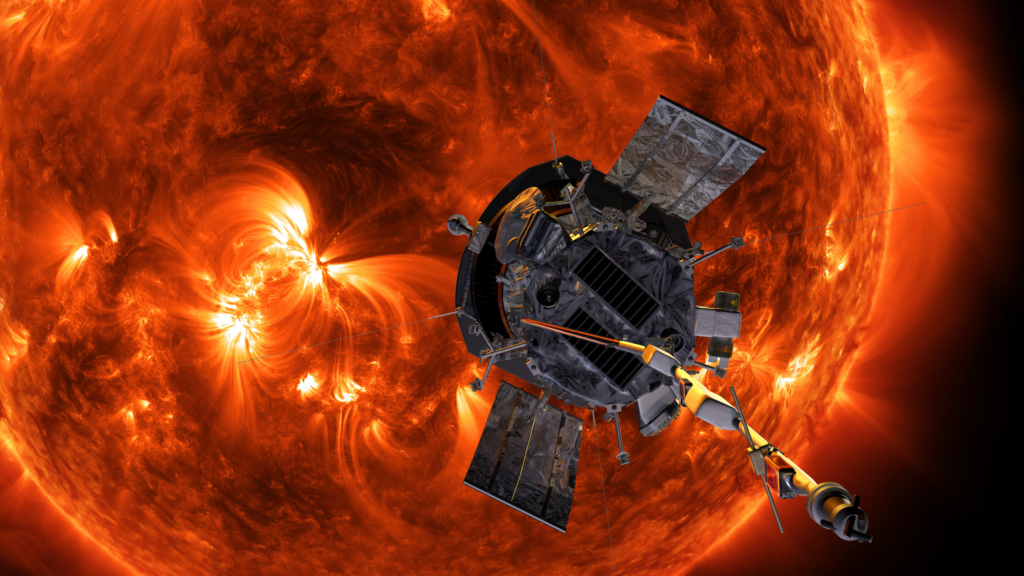Solar wind origins? Solar scientists have sought an explanation for decades. The Parker Solar Probe is revealing where this torrent of particles leaves our star into interplanetary space.
Parker orbits near the Sun. This flyby would kill any other spacecraft. However, this probe was designed for near visits to collect in-situ data on the outer atmosphere (corona) and unusual “breaks” in it called coronal holes. That allowed it to directly observe “fast” solar winds.
Fast Solar Winds’ Secret
Parker found streams of high-energy particles that resemble “supergranulation” flows within coronal holes, according to a team led by Stuart D. Bale (UC Berkeley) and James Drake (UMD-College Park).
The device detected “magnetic reconnection,” which causes the rapid wind component. Coronal holes are solar showers. Jets of energetic particles from the Sun travel along magnetic field lines. These showerhead “funnels” disrupt magnetic fields when two polarities meet. They quickly rejoin, releasing charged particles as part of the fast solar wind.
“The photosphere is covered by convection cells, like a boiling pot of water, and the larger scale convection flow is called supergranulation,” Bale explained. “When these supergranulation cells meet and go downward, they drag the magnetic field into this downward funnel. Jammed magnetic fields intensify. It’s like a magnetic field drain. The solar probe is revealing the funnels’ spatial separation.

Bale noted that funnel reconnection powers the solar wind only in certain coronal hole regions. He stated it arises from convection flows’ magnetic energy bundles. “Our results strongly suggest reconnection.”
Solar Wind
Since 1859, scientists have known about the solar wind. Carrington linked the eruption to a geomagnetic storm a day later. Arthur Eddington, Kristian Birkeland, and Ludwig Biermann also studied the phenomena. Others discovered this solar activity affected comet plasma tails. Due to decades of comet sightings and correlations with Ulysses spacecraft, Halley Armada, and other probe data, that phenomena is well recognized.
Solar wind blows everywhere. Its density (particle count), temperature, and speed vary. All solar latitudes and longitudes display these fluctuations. They evolve.
This breeze has quick and slow components. Both regimes effect solar system planets and comets. It generates “space weather” on Earth, aurorae on Jupiter and Saturn, and erodes the Martian atmosphere.
The sluggish solar wind goes at 300-500 kilometers per second, whereas the rapid component moves about 750 kilometers per second. Both components seem to have slightly different origins. The slow-speed wind comes from the Sun’s “streamer” band around the equator. Parker studied coronal holes that produce rapid solar wind.

Coronal Holes 2.0
These are not “holes” in the Sun. Magnetic field lines leave the Sun’s photosphere without looping back. Instead, they form wide field lines that cover most of the Sun’s area. Coronal holes frequently stay at the poles when the Sun is quiet. Their rapid solar wind seldom hits Earth.
The Sun’s magnetic field rotates every 11 years, increasing activity. Coronal holes can appear everywhere with high activity. During “solar maximum,” high-speed solar wind can hit Earth directly.
Solar physicists have no idea how coronal holes generate solar wind. Solar wind must pass through the Sun’s corona. That flood of charged particles reaches Earth and other solar observatories as a blur.

Fast Solar Wind Birthplaces
Parker approached the Sun at 25 solar radii (21 million miles). That flyby, the probe targeted coronal holes. It saw the fine “funnel structures” that create high-speed flow. The Parker Solar Probe project scientist at the Applied Physics Laboratory, Nour Raouafi, believes funnel formations are connected to brilliant jetlets visible from Earth within coronal holes.
“Solving the solar wind mystery has been a six-decade dream of many generations of scientists,” said Raouafi. “We are grasping the physical phenomenon that drives the solar wind at its source—the corona.”
Looking into the fast solar wind’s birthplaces isn’t only solar physics. Parker and other space and ground solar observatories help anticipate solar storms. The solar wind causes geomagnetic disturbances that can damage satellites, communications networks, and power grids on Earth.
Drake stated, “Winds carry lots of information from the Sun to Earth, so understanding the mechanism behind the sun’s wind is important for practical reasons on Earth. “That will affect our understanding of how the sun releases energy and drives geomagnetic storms, which threaten our communication networks.”
